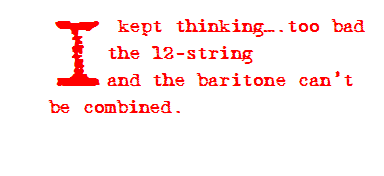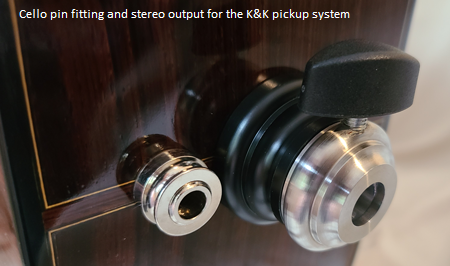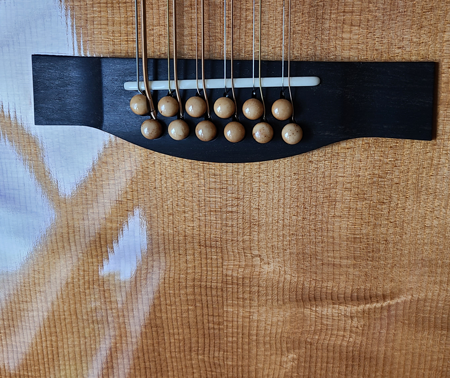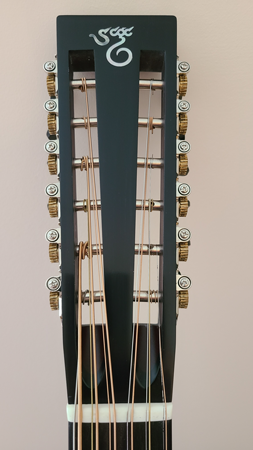
Photos Specifications String Gauge Chart Dan Roberts on the DKK-12
The Santa Cruz DKK-12 Contraguitar C3
UPDATE: July 2021. The DKK-12 has been converted from a
baritone guitar to a Contraguitar and renamed as C3.
Contraguitar tuning is one full octave
below guitar tuning. C3 received a new nut with improved spacing,
spacing adjustments at the saddle, a
stereo K&K systems
pickup, and a
New Harmony cello endpin fitting to enable playing in cello position.
The Beginning:
In October 2005, I spoke with Dan Roberts of
Santa Cruz Guitars
about a new idea: a 12-string baritone guitar. As far as I knew, this had never
been done.
The
Background: After I had finished the final mixes of
Scalar Fields in fall 2005, and sent the
master off to the label, I was thinking about the Santa Cruz DKK
Extended
Baritone and the Martin 12-string which I played on
Scalar Fields. On that album,
those are my two favorite instruments; texturally, musically, etc. I would be
out for hikes or on long drives and just think about those two instruments, and
the different roles each filled on that album..
They're both so different from a standard concert-pitch 6-string that they're basically two
entirely other instruments. A very different technique is required for each,
both occupy very different registers and harmonic terrain; the textures of each are almost
diametrically opposed; each require separate writing approaches, etc. My approach for each is so diverse that Siegfried has noted that I play
so dissimilarly on each that it's
like two different people. So I kept on thinking about the 12 and the
baritone. I was on a hike in the forest one day, and the thought
occurred to me, "Too bad
the 12-string and the baritone can't be combined." It was the proverbial light bulb
going off in my head. The three basic tuning configurations came to me almost
instantly. I called Dan at SCGC the next day, and told him about my
idea. I proposed that we build a 12-string version of the DKK.
 The
Tunings: The DKK-12 will be set up for three basic
tuning configurations;
all based on F#. The
primary tuning will be octave pairs on each string (root + octave). This differs
from a standard 12-sting, which only has octave strings on four of the pairs;
the other two courses are unison strings. Another possible tuning will be root + fifth,
and a third tuning configuration which will be root + 12th (octave plus a fifth). Since the basic
tuning is F#, which is only one whole step above a bass, the octave strings can be tuned
higher. This introduces the possibility of alternate tunings which would not be possible with a
standard 12-string. The alternate tunings will allow for some very densely voiced chord
structures, which would be impossible on any other guitar; be it 6- or 12-string.
I had been working on some solo guitar compositions based on tonal elements and
harmonic structures from various 20th century modern classical orchestral
compositions, but prior to the DKK-12, the instrument to perform them didn't
exist. These compositions have expanded to include elements from various string
quartets, solo piano, and chamber compositions; as well as orchestral harmonic
structures. Much of the demanding harmonic content of these pieces would have
required two, and in some cases, three guitars. With the tuning possibilities of
the DKK-12, these dense harmonic and chordal textures will now be attainable on
a single instrument. Furthermore, the DKK-12 will, for me, broaden the
scope of solo guitar composition and performance.
The
Tunings: The DKK-12 will be set up for three basic
tuning configurations;
all based on F#. The
primary tuning will be octave pairs on each string (root + octave). This differs
from a standard 12-sting, which only has octave strings on four of the pairs;
the other two courses are unison strings. Another possible tuning will be root + fifth,
and a third tuning configuration which will be root + 12th (octave plus a fifth). Since the basic
tuning is F#, which is only one whole step above a bass, the octave strings can be tuned
higher. This introduces the possibility of alternate tunings which would not be possible with a
standard 12-string. The alternate tunings will allow for some very densely voiced chord
structures, which would be impossible on any other guitar; be it 6- or 12-string.
I had been working on some solo guitar compositions based on tonal elements and
harmonic structures from various 20th century modern classical orchestral
compositions, but prior to the DKK-12, the instrument to perform them didn't
exist. These compositions have expanded to include elements from various string
quartets, solo piano, and chamber compositions; as well as orchestral harmonic
structures. Much of the demanding harmonic content of these pieces would have
required two, and in some cases, three guitars. With the tuning possibilities of
the DKK-12, these dense harmonic and chordal textures will now be attainable on
a single instrument. Furthermore, the DKK-12 will, for me, broaden the
scope of solo guitar composition and performance.
The Design: October 2005: the DKK had been with me for six months. Those six months were pretty intense, what with recording an album using such a new instrument. By this time, it had become quite apparent that the design of the DKK was very successful; both tonally and in playability. The DKK required over three years of experimentation and design, and it had really paid off with a very successful instrument. Therefore, I wanted to base the DKK-12 on the design and specifications of the DKK. Even to the extent of specifying the same tonewood combinations: cocobolo rosewood for the back and sides, and Carpathian spruce for the top. All the unusual design features such as the 13-fret D-type body, the 28.5 inch scale length; as well as the cutaway and the slothead would be present on the DKK-12. Dan readily agreed, and set out to search for the ideal set of cocobolo rosewood for the back and sides; as well as a Carpathian red spruce top set which would have the same rich tonal properties of the DKK. One thing which I do know about Dan: he refuses to rush the tonewood selection process. In 2000, when we collaborated on my first Santa Cruz, a D cutaway, the search for the right cocobolo rosewood set took eight months. It was well worth it, and this proved to me early on just how uncompromising Dan could be when searching for the exact right set. At the outset of this process in 2000, after many talks about the tonal properties I sought, I put the final tonewood selection decision in Dan's hands, and would for every guitar thereafter. In December 2005, after a couple of months of searching and examining many cocobolo sets, Dan called with the news that he had narrowed his search down to two sets which would be tonally optimal for the DKK-12. He described both sets; their densities, color, grain, how well quartered they were; as well as their resonances. Dan tapped each set while on the phone with me late that December night, and described what he perceived to be the strengths of each set. Based on the tap tones, he would describe which set would work best in which registers, and what could be expected from each in tonal variances. This process served to truly hone our tonal ideal, and by the end of the night, based on the tap tones and what I was looking for in tonal properties, response, and balance, Dan selected our cocobolo rosewood back and sides set.
 We
had many discussions about the desired tonal properties; this was going to be a
monumental challenge for Dan and Santa Cruz in that we were designing an
instrument which was to have a bass register only one whole step above a bass,
while simultaneously having an extended treble register, due to the cutaway and
the full complement of octave strings. This would result in a guitar with a far
wider range and registers than Santa Cruz had ever designed or built. When we were designing the DKK, I had wanted it to be voiced
more towards the bass end of the spectrum. This was exactly the correct
approach for this instrument, and this greatly contributed to just how very
successful it turned out to be. However, for the DKK-12, I wanted it to be
as balanced in all registers as possible. In fact, I had concerns as to just how physically possible
this would be. The DKK had both a deep and thunderous bass register, along with
a very lush and rich, sonorous upper register. I was both excited and relieved that Dan had located a
cocobolo set about which he felt so confident. However, the critical top still
remained to be found. Due to the exemplary balance and tone in all registers on
the DKK, I had my heart set on Carpathian spruce. Another factor key to my
tonal preferences is a wide-grained top. Carpathian spruce has that in
excess; as well as being very stiff. A couple of weeks after locating the
cocobolo set, Dan called to tell me that he had good news and bad news. He was
unable to locate an exceptional Carpathian top. The good news was that he had
found a top which he thought would be much better than Carpathian for this
instrument: a set of old-growth bearclaw Sitka from a special tree which had
stood dead in the Alaskan forest for many years prior to being cut. Dan began to
describe the set to me: unusually wide-grained for Sitka, so dark in color that
it
resembled cedar which in Dan's experience foretold a very light, stiff, and
exceedingly resonant
Sitka. I balked, since I really thought that Carpathian spruce would be
perfect, based on the DKK's tonal success. Dan said that he would continue
searching for the perfect Carpathian set. What he didn't tell me was that he had
bought and set aside the rare Sitka set. A couple more weeks passed, and I
received another
phone call from Dan. He had located some Carpathian which would be very good for
the DKK-12; however, he again spoke about the Sitka, stating that he
thought it would be much better in this case. Dan stated that this set of
old-growth Sitka
was absolutely some of the best and stiffest he'd ever encountered, as well as
having an incredible tap tone, especially for this instrument. There were only two sets of this available; the other set had been used
as the top on a
Santa Cruz 000 model for
guitarist
Norman Blake. Upon hearing the rare
Sitka-topped 000, Norman, who is a well-known vintage instrument aficionado,
told Santa Cruz that this was by far the best sounding new guitar he had ever
heard. I asked Dan if this set of Sitka would be as ideal for this guitar as the
Carpathian was for the DKK. Dan's response was simple but firm: "More so." On
top of all of this, I could hear the enthusiasm and excitement in Dan's voice each time he'd
spoken about it, and for someone who has seen and heard as many sets of tonewood
as Dan, being excited and impressed with a set did not happen often or easily.
This was to be the fourth Santa Cruz which Dan had built for me, and I learned
several years ago to trust his judgment in these matters. So, I told him to go
with the Sitka.
We
had many discussions about the desired tonal properties; this was going to be a
monumental challenge for Dan and Santa Cruz in that we were designing an
instrument which was to have a bass register only one whole step above a bass,
while simultaneously having an extended treble register, due to the cutaway and
the full complement of octave strings. This would result in a guitar with a far
wider range and registers than Santa Cruz had ever designed or built. When we were designing the DKK, I had wanted it to be voiced
more towards the bass end of the spectrum. This was exactly the correct
approach for this instrument, and this greatly contributed to just how very
successful it turned out to be. However, for the DKK-12, I wanted it to be
as balanced in all registers as possible. In fact, I had concerns as to just how physically possible
this would be. The DKK had both a deep and thunderous bass register, along with
a very lush and rich, sonorous upper register. I was both excited and relieved that Dan had located a
cocobolo set about which he felt so confident. However, the critical top still
remained to be found. Due to the exemplary balance and tone in all registers on
the DKK, I had my heart set on Carpathian spruce. Another factor key to my
tonal preferences is a wide-grained top. Carpathian spruce has that in
excess; as well as being very stiff. A couple of weeks after locating the
cocobolo set, Dan called to tell me that he had good news and bad news. He was
unable to locate an exceptional Carpathian top. The good news was that he had
found a top which he thought would be much better than Carpathian for this
instrument: a set of old-growth bearclaw Sitka from a special tree which had
stood dead in the Alaskan forest for many years prior to being cut. Dan began to
describe the set to me: unusually wide-grained for Sitka, so dark in color that
it
resembled cedar which in Dan's experience foretold a very light, stiff, and
exceedingly resonant
Sitka. I balked, since I really thought that Carpathian spruce would be
perfect, based on the DKK's tonal success. Dan said that he would continue
searching for the perfect Carpathian set. What he didn't tell me was that he had
bought and set aside the rare Sitka set. A couple more weeks passed, and I
received another
phone call from Dan. He had located some Carpathian which would be very good for
the DKK-12; however, he again spoke about the Sitka, stating that he
thought it would be much better in this case. Dan stated that this set of
old-growth Sitka
was absolutely some of the best and stiffest he'd ever encountered, as well as
having an incredible tap tone, especially for this instrument. There were only two sets of this available; the other set had been used
as the top on a
Santa Cruz 000 model for
guitarist
Norman Blake. Upon hearing the rare
Sitka-topped 000, Norman, who is a well-known vintage instrument aficionado,
told Santa Cruz that this was by far the best sounding new guitar he had ever
heard. I asked Dan if this set of Sitka would be as ideal for this guitar as the
Carpathian was for the DKK. Dan's response was simple but firm: "More so." On
top of all of this, I could hear the enthusiasm and excitement in Dan's voice each time he'd
spoken about it, and for someone who has seen and heard as many sets of tonewood
as Dan, being excited and impressed with a set did not happen often or easily.
This was to be the fourth Santa Cruz which Dan had built for me, and I learned
several years ago to trust his judgment in these matters. So, I told him to go
with the Sitka.
The Build: January 2006. With tonewood sets selected, work
began. Dan tackled the bracing design and I set out to determine string gauges. Since I had been
experimenting with baritone string gauges for over three years, I had a pretty
good idea of a starting point with the gauging. Yet this was a 12-string
baritone, so even more variables came into play; the tonal responses of specific
gauges, stresses on the neck, and which gauging would result in a balanced
action and response. While this is still in an experimental stage, I've settled on a
set of gauges which is working very well; both
tonally and for a good balanced action.
 Dan tried something that
neither he nor Santa Cruz had ever attempted: mixing the types of wood for
the
top bracing. The reasoning behind this wasn't simply to have mixed bracing
types, but to have the optimum bracing for such an unusual set of demands, no
matter what the material. The
X brace was to be of Sitka, and the
tone bars and finger
braces of Adirondack red spruce. Dan made this decision not merely to have
mixed bracing types, but based on the
resonance of the bracing stock, and it just turned out that the best results
would be achieved by using Sitka for the X brace, and Adirondack for the rest of the
bracing. The specific maple bridge plate was selected based on its strong, bell-like tone when
dropped onto a hard surface. The specific braces and tone bars would be
carved by Dan, and
the top voiced by him. An aggregate blending of carving and shaping was
selected: the braces would be not only
scalloped, but also
double-tapered. I asked Dan if he had any figured ebony
stashed away which could be used as the headstock overlay. In fact he did
have a piece of rare African curly ebony, and this was selected to be
our
overlay. The final specs for determining the neck and fingerboard
details took a bit
longer than planned, as I wanted a fingerboard radius of 12 inches, instead of
the usual 14 or 16. With such a wide nut, I felt that a tighter radius
would make the neck width seem more manageable, and make for easier long reaches
for things like cluster chord voicings. Also, the nut width was to be
1
15/16" with a dart on a slothead, with a V-neck profile. Like so many of
the DKK-12 elements, this was yet another bit of uncharted territory for Santa
Cruz. Dan had to research these points to determine if they would be
possible, and fortunately, all of the design elements of the neck and
fingerboard were indeed possible.
Dan tried something that
neither he nor Santa Cruz had ever attempted: mixing the types of wood for
the
top bracing. The reasoning behind this wasn't simply to have mixed bracing
types, but to have the optimum bracing for such an unusual set of demands, no
matter what the material. The
X brace was to be of Sitka, and the
tone bars and finger
braces of Adirondack red spruce. Dan made this decision not merely to have
mixed bracing types, but based on the
resonance of the bracing stock, and it just turned out that the best results
would be achieved by using Sitka for the X brace, and Adirondack for the rest of the
bracing. The specific maple bridge plate was selected based on its strong, bell-like tone when
dropped onto a hard surface. The specific braces and tone bars would be
carved by Dan, and
the top voiced by him. An aggregate blending of carving and shaping was
selected: the braces would be not only
scalloped, but also
double-tapered. I asked Dan if he had any figured ebony
stashed away which could be used as the headstock overlay. In fact he did
have a piece of rare African curly ebony, and this was selected to be
our
overlay. The final specs for determining the neck and fingerboard
details took a bit
longer than planned, as I wanted a fingerboard radius of 12 inches, instead of
the usual 14 or 16. With such a wide nut, I felt that a tighter radius
would make the neck width seem more manageable, and make for easier long reaches
for things like cluster chord voicings. Also, the nut width was to be
1
15/16" with a dart on a slothead, with a V-neck profile. Like so many of
the DKK-12 elements, this was yet another bit of uncharted territory for Santa
Cruz. Dan had to research these points to determine if they would be
possible, and fortunately, all of the design elements of the neck and
fingerboard were indeed possible.
The bridge saddle would be thicker than the standard SCGC saddle at 1/8" and like the DKK, would receive Dan's 10-degree back-slant. This makes for an increased break angle, resulting in improved tonal response and volume. This also makes carving the saddle's intonation a bit easier and more accurate, due to the increased string-to-saddle contact surface. The tuners would require modification, as the Santa Cruz tuners are sized to be 3-on-a-side, meaning that the base plate would be too large for a 12-string's closely-spaced tuners. Dan modified the base plates so that they would fit the standard 12-string headstock slothead spacing. Another tuner modification, which was also performed on the DKK, was drilling out the hole in the tuner barrel of the low F# string, so that the double-wound strings which are required for the longer scale and lower register would pass through.
Dan kept me updated on the progress of the build, and would occasionally send "in-progress" photos (see below). This was very exciting, to see an instrument which I didn't know would be possible come together and begin to take shape. As the work progressed, Dan grew more excited about the concept of a 12-string baritone, despite his initial reticence. As the top and back plates were being braced, carved, and tuned, Dan reported his excitement at how well it was all sounding. While the work was underway, I set about locating a case. One of the problems with the DKK-12 is that no currently available cases would fit. I spoke with Al Calton of Calton Cases, and their largest case would have to be modified to work, and even then it was still questionable. I have two of Al's cases; one for the Santa Cruz D, and also for the DKK. They're great cases, and I was a bit disappointed to find out that I wouldn't be able to use them this time. Plan B was Anvil Cases. After a few conversations with Lee at Anvil, it was apparent that they would be able to build an Anvil ATA case which would be a perfect fit. The case was spec'ed out and ordered, and would be shipped to the Santa Cruz shop prior to the completion of the DKK-12. The Anvil case, although extremely heavy, turned out quite well.
As the DKK-12 was nearing completion, it entered the final phase of work, which is the set-up. This highly critical process involves cutting the nut, carving the bridge saddle, setting the action and intonation, and finalizing the neck angle, among other rather precise steps. Dan and I had many discussions regarding the string spread. On my Martin 12, the distance between courses (string pairs) is comfortable; however, the distance between the strings within each course is a bit wide. Getting the spread to be right was going to be even more of a challenge, since the DKK-12 strings were so much physically larger, and due to the extremely lowered tuning, they would of course vibrate in a wider arc. After many phone calls, e-mails, and photos, Dan believed that he had arrived at the optimum spread for this unique instrument. The action itself was setup to be about 1/64" higher than my Martin 12. As unwieldy as this combination of elements (the nut width, string gauges, 12" fingerboard radius, spread within and between courses) has been, the end result is a neck profile, fingerboard arch, and overall action which is surprisingly comfortable for such a large instrument.
 The
Result: June 2006. On a warm New England spring day, the DKK-12
arrived at its new home. I lugged the massive Anvil case up to the studio,
and opened it for the first time. The first thing I
The
Result: June 2006. On a warm New England spring day, the DKK-12
arrived at its new home. I lugged the massive Anvil case up to the studio,
and opened it for the first time. The first thing I noticed was the rich
darkness of the top; instead of Sitka, it bore a strong resemblance to Western red cedar. I removed it from the case, and
played a few chords and scales. I was stunned. The tone was all I'd
hoped for and more. The thunderous bass of the DKK was there; as well as a
rich; yet sparkling, upper register. My concerns regarding the physical
possibility of a 12-string baritone were put to rest. Not only was it
possible, but it was nothing short of amazing. This was a very
evenly-balanced instrument throughout all its registers. I realized after
a few minutes that I had a big smile on my face. Thus far, the only
change has been the low F# string course. I had originally spec'ed out a .070
for the low F#,
but after hearing and playing it, it became apparent that something heavier was
required. After consulting with Dan, we settled on a .076 double-wound
phosphor bronze F# string. The octave string for this course was
originally a .030, but this seemed a bit light; it didn't "speak" as evenly as
the other strings. I went to a .036, but that was too heavy; the action
was unbalanced and tonally the string was too strident, and didn't blend its
voice well with the other strings. I went to an .032, and that was nicely
balanced; both tonally and in the action. This greatly improved the voicing and the
balance. Thus far, the largest challenge causing me to re-think a
change in technique has been my left hand placement. This guitar demands an exceedingly precise and exact technique; if anything is even slightly off with left
hand and finger placement, it can be very unforgiving. However, when the technique is exactly right for this
instrument, it sings sweetly.
noticed was the rich
darkness of the top; instead of Sitka, it bore a strong resemblance to Western red cedar. I removed it from the case, and
played a few chords and scales. I was stunned. The tone was all I'd
hoped for and more. The thunderous bass of the DKK was there; as well as a
rich; yet sparkling, upper register. My concerns regarding the physical
possibility of a 12-string baritone were put to rest. Not only was it
possible, but it was nothing short of amazing. This was a very
evenly-balanced instrument throughout all its registers. I realized after
a few minutes that I had a big smile on my face. Thus far, the only
change has been the low F# string course. I had originally spec'ed out a .070
for the low F#,
but after hearing and playing it, it became apparent that something heavier was
required. After consulting with Dan, we settled on a .076 double-wound
phosphor bronze F# string. The octave string for this course was
originally a .030, but this seemed a bit light; it didn't "speak" as evenly as
the other strings. I went to a .036, but that was too heavy; the action
was unbalanced and tonally the string was too strident, and didn't blend its
voice well with the other strings. I went to an .032, and that was nicely
balanced; both tonally and in the action. This greatly improved the voicing and the
balance. Thus far, the largest challenge causing me to re-think a
change in technique has been my left hand placement. This guitar demands an exceedingly precise and exact technique; if anything is even slightly off with left
hand and finger placement, it can be very unforgiving. However, when the technique is exactly right for this
instrument, it sings sweetly.
This instrument will be used extensively on the next KastningSiegfried album, and new solo compositions are being written for it as well. I've already received one request to play it on a "special guest" appearance for another artist's upcoming album.
When I began on this project, and from the time I first spoke to Dan about it, I had envisioned a 12-string version of the DKK. The end result was not merely a 12-string version of the DKK, which was what I had originally envisioned, but an entirely new instrument which I could not have imagined. One which has clearly staked out its own musical territory, its own tonal terrain, and has certainly introduced an entirely new and original, organic voice to the realm of stringed instruments. It has, and will continue to open new artistic doors and create new challenges for me. All the time, work, and experimentation have been well worth it. To know that Santa Cruz is so supportive of me in my musical experimentation, shows a willingness to be adventurous and isn't afraid to explore entirely new directions means a lot to me. It also speaks highly of them as luthiers and as a company. What once began as an artist endorsement agreement has now blossomed into a partnership. To Richard Hoover, Dan Roberts, and the fine luthiers at Santa Cruz Guitars, I would like to express my sincerest gratitude.
-Kevin Kastning, July 2006
Click a thumbnail to see a larger version of the photo.